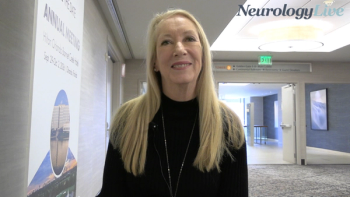
Subgroup Findings of the NURTURE Study, Importance of CMAP Amplitude in SMA: Thomas Crawford, MD

The pediatric neurologist at Johns Hopkins Medicine provided commentary on the subgroup findings from the phase 4 NURTURE study of nusinersen (Spinraza; Biogen) in presymptomatic spinal muscular atrophy. [WATCH TIME: 3 minutes]
WATCH TIME: 3 minutes
"The other was the presence or absence of reflexes, which is a little bit more in the eye of the beholder. You have to be a good neurologist with skill to be able to pull them out, and not everybody can get them all the time."
An update to the phase 4 NURTURE study (NCT02386553) of nusinersen was recently published in Muscle and Nerve, with findings that showed continued treatment benefit in infants with symptomatic spinal muscular atrophy for up to 5 years. Unlike untreated SMA Type 1 patients for whom median time to death or requirement for ventilation support was 13.5 months, all 25 participants were alive at the final visit, and none required permanent respiratory ventilation. Children with 3 SMN2 copies (n = 10) achieved all World Health Organization (WHO) motor milestones, with all but 1 milestone in 1 child within normal developmental timeframes.
Investigators investigated a subgroup of participants with 2 SMN2 copies who at baseline were not areflexic and had peroneal compound muscle action potential (CMAP) amplitude volumes greater than 2 mV, the same criteria used in the SPR1NT trial of onasemnogene abeparvovec (Zolgensma; Novartis). Otherwise known as subgroup 1, these 8 children were of similar age at first nusinersen dose, had similar baseline Hammersmith Infant Neurologoic Examination, Section 2 scores, and their baseline Children’s Hospital of Philadelphia Infant Test of Neuromuscular Disorders scores were higher in comparison with all children in NURTURE with 2 SMN2 copies.
Data showed that a higher proportion of children in subgroup 1 achieved WHO motor milestones within normal developmental timeframes vs the overall NURTURE group with 2 SMN2 copies. Overall, these data suggest that even relatively small differences in inclusion/exclusion criteria and baseline characteristics impact clinical outcomes observed during long-term follow-up and are important to consider when comparing clinical treatment trials.
Following the publication, NeurologyLive® sat down with lead investigator
REFERENCE
1. Crawford TO, Swoboda KJ, De Vivo D, et al. Continued benefit of nusinersen initiated in the presymptomatic stage of spinal muscular atrophy: 5-year update of the NURTURE study. Muscle & Nerve. 2023;68(2):157-170. doi:10.1002/mus.27853
Newsletter
Keep your finger on the pulse of neurology—subscribe to NeurologyLive for expert interviews, new data, and breakthrough treatment updates.




































